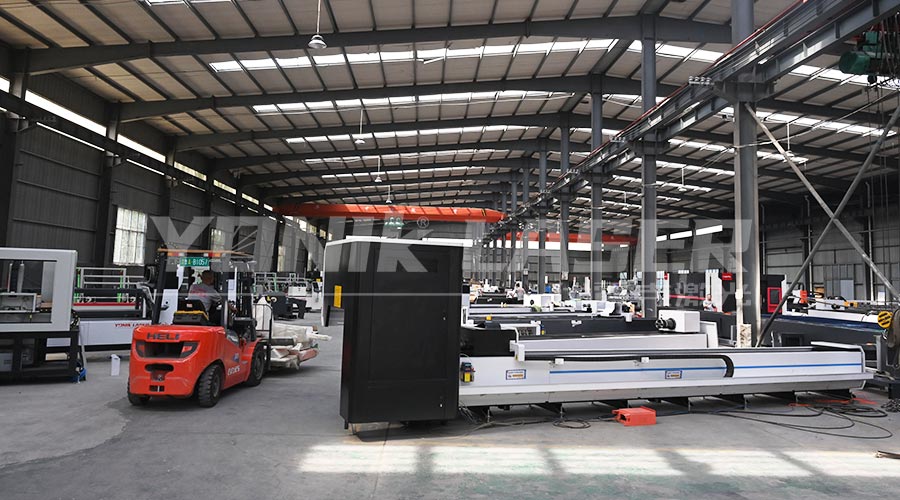Laser cutting machines, as the core equipment of modern industrial manufacturing, occupy an important position in the field of metal processing due to their advantages of high efficiency and precision. However, many users encounter the problem of "unable to cut through metal plates" in practical operation, which not only affects production efficiency but may also cause material waste. This article will analyze in depth the five common causes of incomplete cutting from a technical perspective, and provide targeted solutions to help you quickly identify problems and optimize processing quality.

1、 Insufficient laser power: energy cannot penetrate the material
Reason analysis
Laser power is a key factor determining cutting capability. When the cutting thickness exceeds the rated power range of the equipment, the laser energy is insufficient to completely melt the metal, resulting in residual or non penetrable incisions. For example:
The theoretical upper limit for cutting carbon steel with a 1000W fiber laser is 6mm, and for stainless steel it is 4mm
When the cutting speed does not match the power, even if the power meets the standard, there may still be insufficient energy
Solution
Adjust cutting parameters: Reduce cutting speed appropriately within the allowable range of the equipment and extend the laser action time
Upgrade equipment configuration: If it is necessary to process thick plates for a long time, it is recommended to replace with a higher power laser (such as 2000W or more)
Layered cutting process: Multiple layered cutting is used for ultra thick plates to remove material layer by layer
2、 Focus position deviation: energy density does not meet the standard
Reason analysis
The focal position of the laser beam directly affects the energy density distribution. When the focus deviates from the material surface, the beam diameter increases and the energy density decreases, resulting in a decrease in cutting ability. Common triggers include:
Lens contamination causes optical path deviation
Automatic focusing system malfunction
Nozzle wear affects the stability of airflow field
Solution
Calibrate focus position: Use focus position testing paper (such as acrylic plate ablation method) for precise calibration
Clean optical components: Wipe protective and focusing lenses with anhydrous ethanol every week, and establish regular maintenance records
Replace damaged parts: When the nozzle aperture deformation exceeds 0.1mm, it needs to be replaced immediately
3、 Auxiliary gas abnormality: slag removal failure
Reason analysis
Auxiliary gases (oxygen/nitrogen/compressed air) play three major roles in the cutting process: blowing off slag, participating in oxidation reactions, and cooling the cutting seam. Abnormal gas can cause:
Insufficient air pressure (significantly affecting cutting quality when below 0.8MPa)
Insufficient gas purity (e.g. nitrogen purity must be ≥ 99.95%)
Incorrect selection of gas type (e.g. cutting stainless steel should use nitrogen instead of oxygen)
Solution
Optimize gas parameters: Adjust pressure according to material type (carbon steel oxygen pressure 0.3-0.5MPa, stainless steel nitrogen pressure 1.2-1.5MPa)
Installation of filtration device: Install a three-stage filtration system (oil-water separator+precision filter) in the gas path
Check the sealing of the air circuit: Regularly use soapy water to check whether the air pipe joint is leaking
4、 Material surface issue: abnormal energy reflection/absorption
Reason analysis
The surface state of metal sheet will significantly change the laser absorption rate:
Oxidation layer and oil stains increase reflectivity by 20% -40%
Highly reflective materials such as galvanized sheet and aluminum alloy are prone to energy loss
Uneven board causing changes in focal length
Solution
Pre treated board surface: Polish the oxide layer with sandpaper and remove oil stains with alkaline solution
Add absorption coating: Spray graphite or phosphate coating on high reflective materials (increase absorption rate to over 60%)
Adjust cutting angle: Use dynamic focusing function for warped boards to maintain a constant relative focus position
5、 Equipment degradation: core component performance decreases
Reason analysis
The performance degradation of core components such as lasers and cutting heads can directly lead to a decrease in cutting capability
Laser output power attenuation exceeds 10%
The transmittance of the light guiding system lens decreases (it is recommended to replace it when the transmittance is less than 95%)
The wear of the guide rail leads to a deviation in positioning accuracy (if the error is greater than 0.05mm, calibration is required)
Solution
Implement TPM management: Establish laser power detection records (tested once a month)
Preventive maintenance: replace fiber end caps every 2000 hours and lubricate guide rails every 500 hours
System upgrade and renovation: Upgrade the optical system of equipment that has been in use for more than 5 years, and replace the collimating lens group
Conclusion: Establishing a standardized cutting quality control system
To solve the problem of incomplete cutting, a systematic solution needs to be established from four dimensions: equipment, materials, processes, and environment. Suggested companies:
Develop a cutting parameter database (recording material type, thickness, gas parameters, etc.)
Implement ISO9011 equipment inspection standard (check air pressure, optical path, and cooling system before starting up daily)
Configure online monitoring system (real-time monitoring of cutting speed, focal position, gas flow rate)
If you need to obtain the "Laser Cutting Process Parameter Comparison Table" or make an appointment for equipment diagnostic services, please submit your requirements through the website form. Our engineers will provide professional technical support within 2 hours. Stay tuned to our website for more practical skills and industry insights in the field of laser processing!
Related keywords: laser cutting machine maintenance, metal cutting parameter optimization, high anti material cutting scheme, laser power detection, auxiliary gas selection guide
2025-07-22
2025-07-21
2025-07-19